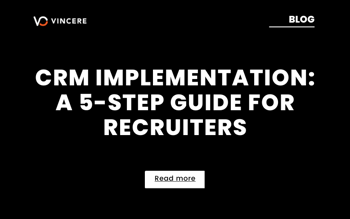
You just got a shiny new recruitment CRM system. You’re excited, maybe nervous. This could be one of the best business decisions you’ll make. But hold up — there’s some bad news. 63% of all CRM projects fail because of a poor CRM implementation process and lack of user adoption. Nobody wants to be part of that statistic.
That’s why it’s on you and your team to nail your CRM rollout. We’re here with some advice. Based on our years of experience in implementing Vincere’s software across global recruitment firms successfully, we’ve come up with an Ultimate Guide to get your Recruitment CRM system up and running smoothly.
Choosing the right Recruitment CRM system for your business
A recruitment CRM system, or customer relationship management system, is a software tool that helps businesses manage their customer data. This type of platform can help staffing agencies keep track of their clients, candidates, and placements - as well as automate their workflow and improve business efficiency. The right CRM also saves the back-office recruitment software team from process bottlenecks.
When choosing a CRM, you should consider the features that are most relevant to your business. For example, some systems offer applicant tracking systems (ATS), while others don’t. Some have built-in email marketing tools, while others require users to do it manually. Be sure to choose a platform that has the features you need!
Cost of a Recruitment CRM implementation
Aside from the above-mentioned criteria, remember to take into account the CRM’s price and compare it against your set budget.
The initial cost of implementing a CRM can range anywhere from $3,000-$450,000 USD, depending on the size and complexity of your business.
Be sure to factor in the expense of staff training, as well as any expenses for further customizations or integrations that you might need.
You should also consider the time commitment required for implementation. The process can take anywhere from a few weeks to a year or more. Any time spent on a CRM implementation means less time for other projects - but the result can be one of the best investments your business can make.
A 5-step approach to the Recruitment CRM implementation process
1. Get management buy-in
Everything trickles down, including bad attitudes. When making the switch, the first priority is to get management’s enthusiastic endorsement. Their job is to spread the message about the new CRM’s value. If your top leadership doesn't believe in the system, why should anybody else?
2. Build your "dream team"
Watch out, Marvel: these are the new superheroes in town. A good Recruitment CRM system needs a good team to support implementation. When you have positive, capable people tackling the stages of the new system setup, you can’t go wrong.
3. Map out a project timeline
You might not have thought about realistic goal-setting since New Year’s. But this is essential: you will not succeed without defined stages and check-ins. A good project tracker will help your team here, by including milestones and tasks for everyone to manage and collaborate.
4. Communicate change
If you’ve read this far, there’s no doubt that you’re pumped for this new Recruitment CRM system. But does your team feel the same way? People get used to a certain routine, and this new system will upset that. Take charge, demonstrate the new CRM’s value, and give your team a heads-up about major milestones.
5. Prepare for data migration
Now we get to the real treasure: your data. Data migration is the most intensive part of a CRM implementation.
You’ve got plenty to juggle, but here’s our key tip: make sure your data is in order before you switch over. It’s a good idea to declutter now, to save both space and money. You don’t want to pay to move junk.
Another key point: your vendor must export the data in industry-standard SQL format. Worst case scenario: the data is moved, but unreadable. Data integrity is everything, so make sure your vendor will care for it properly (and make a backup just in case).
This is only a fraction of what we can share. Want to know more about the keys to CRM success? Click the link here to get our eBook for recruiters, Nailing Your CRM Rollout Strategy.
Best practices for your Recruitment CRM implementation strategy
Here are a few extra tips to keep in mind when you're planning your CRM implementation project.
First, remember to make it clear who’s responsible for the project. There should be one person or group of people at the top who can field questions, direct strategy, and be the go-to champions for your new system.
When you’re implementing the Recruitment CRM system, try to start with a small pilot group to test the system before rolling it out to other users. Be sure to provide training and support for your users as they transition to the new platform.
Last one: Double- and triple-check your plan for data migration and backup. How you will migrate your data from your old system to the new one is the most important part of getting to a new system, and we can’t stress enough that protecting your data is key.
Final thoughts
Implementing a Recruitment CRM system doesn't have to be difficult - but it does require some planning and preparation. On a side note, this step brings you a foundation for proactive recruitment.
We hope that the tips outlined above will prove to be a valuable resource for recruiters looking to ensure a successful CRM implementation.
You may be interested in:
- CRM for Recruitment Agencies: A Buyer's Guide
- Recruitment CRM System: The Ultimate Guide for your Recruitment Agency